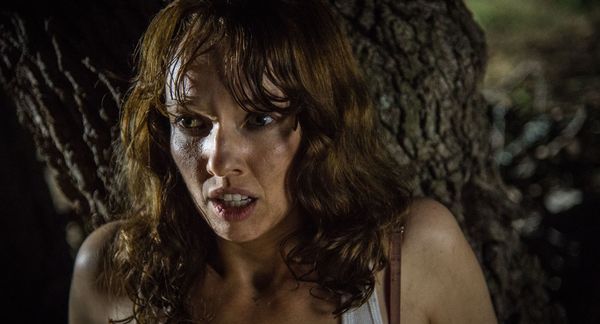Eye For Film >> Movies >> Last Girl Standing (2015) Film Review

By now, most cinemagoers are familiar with the character of Final Girl. She's the last one standing after all the horrors are over, the one who (usually) defeats the killer, be it man or beast. In recent years she's been the subject of a number of narrative experiments, from All The Boys Love Mandy Lane to You're Next to Final Girl itself. Last Girl Standing takes a more prosaic but equally troubling approach, asking what happens to this character after the credits have rolled.
Camryn (Akasha Villalobos) is the sole survivor of a campsite massacre committed by a hooded man nicknamed The Hunter. The opening scenes of the film show us the end of this attack in a style that will prompt smiles as much as shivers from horror fans, which is a good way to start, because those smiles will have to sustain viewers through a lot of tough stuff to come. This is because the rest of the film deals with something which the everything-is-alright-in-the-end fairytale structure of traditional horror doesn't generally allow for: post traumatic stress disorder.

As anyone who has suffered from PTSD will know, real life doesn't often do neat endings. It's even tougher to set aside the fears that stem from trauma if one has press sensationalism to deal with. We see clippings of newspaper reports about the killings. Camryn obsessively collects them. They query whether or not the killer is really dead. They suggest an occult dimension to what happened. They reveal that the killer has fans. All of these are, of course, popular horror film tropes; some of them can be read in additional ways in the context of the story that develops. Most significantly, they illustrate the kind of difficulty PTSD creates for sufferers as real life blurs with paranoid fantasy. The crucial factor is that, unlikely as they are, they're possible, and Camryn's brain, clinging to the hyper alertness that saved her at the campsite, sees potential confirmation in the tiniest things. The first half hour of the film delivers this experience full on, using familiar genre tricks (viewing her from behind, inviting us to look into the background in a mirror, jabbing at us with tiny noises and shifts of the light) to deliver far more than the usual dose of fear.
There's a danger that this will sensationalise PTSD, and depictions of the aggression with which Camryn sometimes reacts to this fear, could be seen as problematic in light of the hostility sufferers sometimes face, but the film works around this by adding another character who behaves very differently despite having experienced (and perhaps still experiencing) a similar problem. Furthermore, it very much invites us to sympathise with Camryn, and Akasha Villalobos' utterly committed performance makes for one of the most compelling horror heroines we've seen in years. It's the sort of performance that would be winning her awards if this weren't a genre film - to think that this is only her second feature length film, and the first by director Benjamin R Moody, is remarkable.
The difficulty with a story like this is that it's hard to sustain the pressure, both directly and because of the impact of doing so on the audience. Moody wisely gives us moments of relief, with Camryn gradually getting to know and trust new co-worker Nick (Brian Villalobos); again he resorts to old tricks like shifts in the tone of the incidental music to help the audience, too, develop this relationship, though there remains a constant awareness, shaped by what cinema has taught us, that Nick could turn out to be a threat. Camryn has to find people she can trust in order to have any kind of life at all, and the stress of watching in fear encourages us to root for her in this. Our expectations of genre logic compete with a longing for events to follow a different path.
This is a difficult balancing act to pull off. Moody manages it by blending his painful psychological horror story with something more familiar that appeals to the human desire for symmetry. Whilst some will dismiss this as pastiche it's deceptively layered, and though he may be a little heavy-handed in his use of irony there are elements here that will appeal to genre fans' desire to see a kind of justice done as a minor character abruptly comes to the fore. There's inevitable disappointment stemming from the awareness that either narrative approach might have been more satisfying on its own, bu it seems churlish to demand a five star film when this is a solid four. One is left longing to see what will become of its director and star after the credits roll.
Last Girl Standing is out now on Digital HD and VOD from FrightFest Presents
Reviewed on: 26 Feb 2016
















